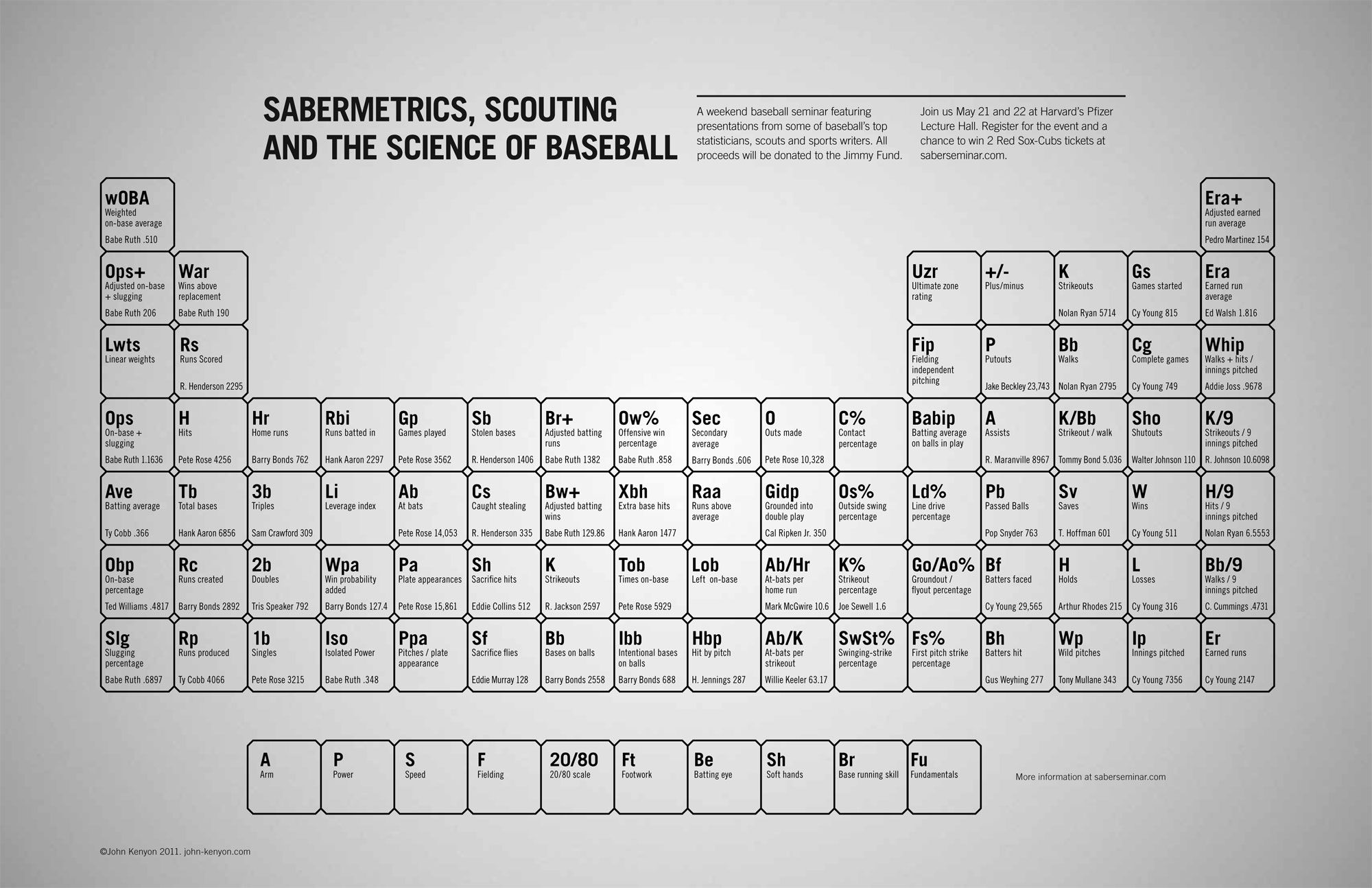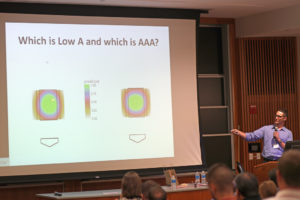Highlights From Saberseminar 2018

There are a handful of events that are hosted throughout the year within the baseball industry that draw fans and enthusiasts from all over the place. From the SABR Conference, to the American Baseball Coaches Convention, to the Winter Meetings, there is no shortage of ways to meet people within the industry; you just have to know where to look. However, one of the newer events that caters to the analytical mind in today’s game is Saberseminar. Not to be confused with SABR, American Society for Baseball Research, Saberseminar, hosted at Boston University, is a two-day conference filled with intellectual presentations speaking to the analytics, science, and technology within baseball. After attending the event myself, I thought it only right to share my experience and highlight some of presentations and takeaways.
First off, I’d like to congratulate all of the speakers at the event. Every single presentation was well thought out and presented with confidence. Moreover, the information being presented was thought-provoking and gave the audience a chance to ask questions and learn during the short time each presenter had to show their work. What’s great about Saberseminar is that anyone is welcome to present (pending approval of a brief abstract first). As a result, presenters ranged from recently graduated high school seniors to some of the brightest minds with years of experience in analytics and physics. So, without further ado, here are a few areas I thought were worth highlighting from this past weekend’s presentations.
The Home Run Spike
Two presentations that stuck with me throughout the two-day event covered the topic of the surging home run rate. This has been a frequent topic of conversation since the introduction of new and slightly different baseballs; Major League Baseball even hired a committee to conduct thorough research on the matter to see if there was anything that could be found to crack the code. That committee from the commissioner’s report on the home run rate presented their findings at Saberseminar.
The team, led by Alan Nathan, Professor Emeritus of Physics at the University of Illinois at Urbana-Champaign, set out to look at three factors that could have an effect on the increasing homerun rate. The first being the ball itself. When Rawlings, the manufacturer of the baseballs, produced new balls used for in-game use, questions started to arise from fans, players, and others within the game. As a result, the committee went straight to the source at Rawlings manufacturing facility in Costa Rica.
One factor the team wanted to test was coefficient of restitution (COR), or simply put, the bounciness of the ball. The theory being that since the ball loses energy coming off of the bat, testing the new baseballs for an increased COR was a viable method. Tests conducted to objectify the baseball’s COR at UMASS Lowell and Washington State University both suggested that the COR is sufficient with what should be occurring and is not a cause of the homerun spike; leaving the “juiced ball” theory out of the equation.
Secondly, the team looked at batter and pitcher tendencies to see if they had any contribution to the rise in home runs. Using StatCast data, the committee actually found a slight decrease in exit velocity from 2016-2017, which would insinuate a decrease in home runs. Moreover, the team found that there is little indication that the sudden craze in launch angles and exit velocities are a likely contributor because these numbers have been consistent over the set of distribution.
In addition, the team reported that there is a “global” increase in home runs, meaning that the share of the home run spike is affecting a wide range of players. The committee also looked at the effect of pitchers on the matter by identifying pitches that are more likely to result in home runs as opposed to those that have a history of the opposite. By testing four quadrants of the strike-zone among 8 different pitch-types, one can expect to see a shift in strategy to combat “high risk” home run pitches and vice versa. There were no findings of the like, and as a result, they were able to rule out the effect of batter and pitcher tendencies.
Lastly, the team covered the aerodynamics of the ball. Three factors contribute to the flight of a ball – lift (the upward trajectory of the baseball), gravity (the downward trajectory), and drag (the pull on the baseball). After study, the researchers concluded that that the drag coefficient had decreased since 2015, making the ball travel farther. This may play a major role in the home run spike. The question then becomes, what has created this decrease in drag? That’s where I found Dr. Meredith Wills’ presentation to be interesting. A sports data analyst with a PhD in Astrophysics, she too presented on the home run spike. Only her presentation may have found an answer to our why.
Dr. Wills actually took apart a baseball down to its core and realized that the stitching of the baseball was different than the pre-2014 baseballs in terms of the laces being nine percent bigger. She suggests that not only could this be the cause of the home run spike, but the cause for the spike in pitcher blisters as well.
The two theories are quite interesting and shed light on a lot of questions the baseball community had. While there could have been additional factors that can contribute to the spike, such as weather, the findings from both presentations were succinct. You can read the official summary of the committee’s findings here as well as view Dr. Meredith’s full presentation via YouTube.
The Strike Zone
While we’ve come to realize that the strike zone is more-oft-than-not a subjective measure based on whoever is behind the plate that day, a couple of presentations raised larger questions surrounding the effects the changes in the strike zone have on the game in general. Andy Andres, professor at Boston University and course instructor for EdX’s Sabermetrics 101, presented his findings on the strike zone and its effects on duration of game. In addition, former player Nate Freiman, currently writing for FanGraphs, presented his work on the strike zone and its different call probabilities at different levels of the game.
Andy Andres’ presentation was interesting because we don’t often think of the strike zone in being a large factor in the length of games. However, in a simplified version, he argued that the larger the strike zone, the quicker the games. Whereas Nate Freiman presented his findings on the strike probability at each level of the game, he suggested that as one increases in level-of-play (i.e. low-A, high-A, double-A, triple-A), the strike zone becomes more congruent to the general location of the strike zone rectangle. You can read his findings in-full straight from the FanGraphs website here (highly recommend).
The most interesting part of the two presentations to me was the realization that there is indeed a need for some sort of objectivity within strike/ball calling. Data actually shows that in practice, , the strike zone is actually a circle. Balls that centered toward the middle of the zone had the highest probability of being called a strike. On the outer edges, mainly the corners, even those that reside within the confinements of the traditional rectangle, are called balls. With the implementation of technology at our disposal, it begs the question of why would we not help the home plate umpire to make a more objective ruling?
The State of the Game
Lastly, and perhaps the most thought-provoking presentation of the weekend, came from former Rays player Fernando Perez. In a somber tone, he urged all of us as baseball fans and industry-goers to take a deep look on the impact the game today has on the younger generation. He made the case that those without an obvious team to root for should seriously consider the Tampa Bay Rays. The Rays, Perez says, are an embodiment of a new generation of ideas within the game of baseball, regardless of the fact that their market size nearly forces them to think outside the box.
Perez worries that the recent emphasis on stats and data driven decision making have made baseball perhaps a more precise version of itself, it may be hurting the game’s reputation among causal fans. Perez suggested that recent changes in pace of play, video accessibility and the focus on the entertainment value of hte game are positives and good for the future of the sport. Baseball, as an industry, must find a healthy balance of maintaining the level of intellect within the game, while appealing to the general audience who may not know (or care to learn) about things like wOBA, xFIP, and WAR.
Conclusion
Overall, the event itself was a wonderful blend of wisdom, learning, and sheer enjoyment from an insider and fan’s perspective. Add in the fact that all proceeds are donated to a cause, and it really makes for an incredible outing. This year, Saberseminar was able to donate $30,000 to the Angioma Alliance and send $2,000 to the Young Center for Immigrant Children’s Rights. Not to mention Saberseminar’s involvement with MLB’s Diversity Pipeline Program. If youre unfamiliar, the group, run by Tyrone Brooks, focuses on the inclusion of minorities and women within baseball. Moreover, many of Saberseminar’s presentations were given by students who were awarded scholarships. Whether you are a job-seeker or a fan of the game, I highly suggest you make your way over to Boston for the 2019 conference. You won’t be disappointed.
– Mike Lambiaso
A special thanks to all of the presenters to who shared their findings and research, as well as Chuck and Dan for putting on an incredible event. I look forward to seeing the growth of the event and attending for years to come.















